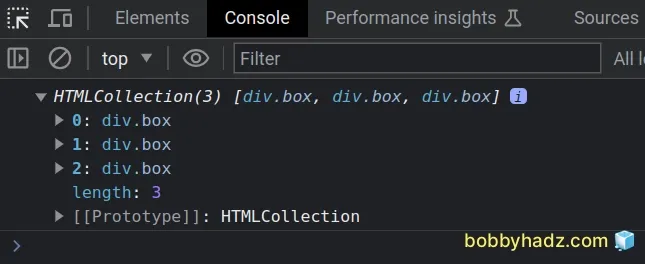TypeError: addEventListener is not a function in JavaScript
Last updated: Mar 3, 2024
Reading time·3 min

# TypeError: addEventListener is not a function in JavaScript
The "TypeError: addEventListener is not a function" error occurs for multiple reasons:
- Calling the method on an object that is not a valid DOM element.
- Placing the JS script tag above the code that declares the DOM elements.
- Misspelling the
addEventListenermethod (it's case-sensitive).

Here is an example of how the error occurs.
<!DOCTYPE html> <html lang="en"> <head> <meta charset="UTF-8" /> </head> <body> <div class="box">Box 1</div> <div class="box">Box 2</div> <div class="box">Box 3</div> <!-- ✅ Your JS script here ✅ --> <script src="index.js"></script> </body> </html>
And here is the related JavaScript code.
const boxes = document.getElementsByClassName('box'); console.log(boxes); // 👉️ [div.box, div.box, div.box] // ⛔️ TypeError: boxes.addEventListener is not a function boxes.addEventListener('click', function onClick() { console.log('box clicked'); });
We got the error because we called the
addEventListener
method on the array-like object that the getElementsByClassName method
returns.
Notice that in our HTML file, we placed the index.js script at the bottom of
the body tag, after the DOM elements.
To solve the "addEventListener is not a function" error, make sure to call the
addEventListener() method on a valid DOM element, or the document or
window objects, and place the JS script tag at the bottom of the body tag in
your HTML.
const boxes = document.getElementsByClassName('box'); console.log(boxes); // 👉️ [div.box, div.box, div.box] // ✅ addEventListener to first box boxes[0].addEventListener('click', function onClick() { console.log('box clicked'); }); // ✅ addEventListener to all boxes for (const box of boxes) { box.addEventListener('click', function onClick() { console.log('box clicked'); }); }

The first example calls the addEventListener method on the first element in
the array-like object.
The second example shows how to iterate over the div elements to add an event
listener to each.
addEventListener wrong.You can also console.log the element you are calling the method on.
addEventListener method on a valid DOM element, or on the Document or Window objects.# Check if the element exists before calling addEventListener
If the element you're calling the method on sometimes doesn't exist,
conditionally
check if the element is there
before calling the addEventListener method.
For example, a basic DOM element has a type of object, so we can check if the
value is an object and contains the addEventListener property before calling
the method.
const box = null; if ( typeof box === 'object' && box !== null && 'addEventListener' in box ) { box.addEventListener('click', function onClick() { console.log('box clicked'); }); }
Our if condition uses the logical AND (&&) operator. For the if block to
run, all conditions have to be met.
We first check if the box variable
stores a value with a type of object,
because DOM elements have a type of object.
Then we
check if the variable is not equal to null.
Unfortunately, if you check the type of null with console.log(typeof null),
you would get an "object" value back, so we have to make sure the value is not
null.
console.log(typeof null); // 👉️ object
addEventListener property.Then we know that we can safely call the addEventListener method on the
object.
# Additional Resources
You can learn more about the related topics by checking out the following tutorials:

